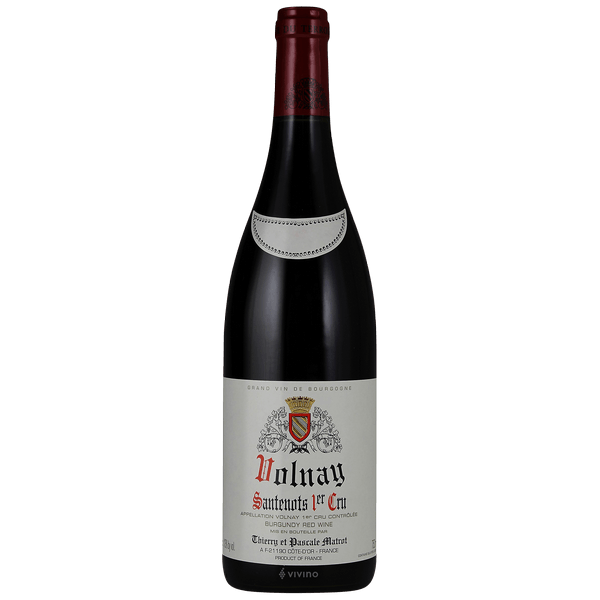2020 Vincent Girardin Volnay Vieilles Vignes
2020 Vincent Girardin Volnay Vieilles Vignes The 2020 Volnay combines nobility, delicacy, elegance and femininity. A delicate violet and berry fragrance. One of the finest representatives of the Côte de Beaune. The Volnay is in the Côte de Beaune what the Chambolle Musigny is in the Côte de Nuits. A feminine wine which is one of the only Burgundy Pinot Noir you can already enjoy and drink when young. But it is also a wine with depth.
Maison Vincent Girardin
The history of Maison Vincent Girardin is relatively recent. In 1980, at the age of 19, Vincent Girardin, the son of a family of winegrowers based in Santenay since the 17th century, decided to strike out on his own and began producing wine from five acres of vines that he had inherited from his parents. From his earliest youth, Vincent had a passion for working with vines and great respect for the potential that they represent; his ambition was to produce his own wine. The quality of his wines was quickly recognized by connoisseurs all over the world, and this enabled him to expand his activity, focusing primarily on the great white and red wines of the Côte de Beaune. To cope with the growing demand for his wines, he developed an approach that was new in Burgundy: he purchased grapes from producers who shared the same philosophy and the same high standards. In 2012 Vincent Girardin sold his operation to a longstanding partner of the Maison. Mr. Nié, President of the Compagnie des Vins d’Autrefois in Beaune, naturally decided to continue with the small team of nine people, who had been faithful to the Maison for many years. Eric Germain continues to uphold the style of the wines and Marco Caschera markets them all over the world.
Pinot Noir
Pinot Noir is the dominant red wine grape of Burgundy, now adopted (and extensively studied) in wine regions all over the world. The variety’s elusive charm has carried it to all manner of vineyards. These extend from western Germany (as Spätburgunder) and northern Italy to Chile, South Africa, Australia, New Zealand and the USA. California, Oregon and New Zealand are arguably the greatest centers for the grape outside its home territory. However great Pinot Noir is made in all of these territories.
The essence of Pinot Noir wine is its aroma of red berries and cherry (fresh red cherries in lighter wines and stewed black cherries in weightier examples). Many of the more complex examples show hints of forest floor. Well-built Pinot Noirs, particularly from warmer harvests, suggest leather and violets, sometimes recalling Syrah. There are two theories regarding the Pinot name. One is that it came about because their bunches are similar in shape to a pine cone (pinot in French). It may derive, however, from a place name in France such as Pinos or Pignols from where cuttings were obtained.
Pignols in the Auvergne, for example, has cultivated Pinot since the Middle Ages. It was previously believed that Pinot Noir, Pinot Blanc, Pinot Gris, Pinot Meunier, Pinot Précoce (Frühburgunder) et al were members of a “”Pinot Family”” of distinct grape varieties. But DNA profiling has shown them to share the same genetic fingerprint. Thus, they should properly be considered as mutations or clones of a common variety.”
Related products
Chateauneuf-du-Pape
2020 Domaine Berthet Rayne Chateauneuf-du-Pape Rouge 2020 Domaine Berthet Rayne Chateauneuf-du-Pape Rouge Aromas of plums, cassis, and cherries presented in a medium bodied, spicy style with beautifully pure fruit, a savory mouthfeel, moderate but ripe, sweet tannin, and a long finish. VARIETAL COMPOSITION: 65% Grenache Noir, 20% Mourvèdre, 10% Cinsault, 5% Syrah. TERROIR: The estate [...]
2021 Francois Villard Les Contours de Deponcins Viognier 2021 Francois Villard Les Contours de Deponcins Viognier Fine yellow; the nose is buttery, on roasted nuts, lime and white strawberry, table wax, has a steady depth. This is a bit New Wave on the palate, moves easily, depth, but continues with some fresh saltiness and assertion, [...]
Chardonnay
2021 Jean-Marc Brocard Chablis Sainte Claire 2021 Jean-Marc Brocard Chablis Sainte Claire is tart, with notes of lemon oils and mango skin, as well as a bit of minty herbaceousness. On the palate, there are flavors of honey, tropical fruits just barely ripened, as well as a finish of bracing acidity. One of the most popular [...]
2016 Domaine Armelle et Bernard Rion Nuits-Saint-Georges 1er Cru Les Damodes 2016 Domaine Armelle et Bernard Rion Nuits-Saint-Georges 1er Cru Les Damodes is light and elegant for the appellation. On palate, high acidity with smooth tannis together with balanced fruits and oak flavor. 2016 vintage Les Damodes is a premier cru site on the Nuits-Saint-Georges [...]



